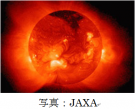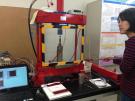Research Theme:Representation Theory
Let's consider what is a square? Here, we take note of "symmetory" of squares. Move a square, and consider ways to overlap with the original position.
We label $ABCD$ to the four vertices of the square in a counterclockwise direction.
Let $\sigma_1$ (resp. $\sigma_2$) be the reflection through the diagonal line $AC$ (resp. diagonal line $BD$), and $\sigma_3$ (resp. $\sigma_4$) be the reflection through the line connecting the midpoint of side $AB$ (resp. side $AD$) and of side $CD$ (resp. side $BC$). Then $\sigma_1$ just change the vertices $B$ and $D$, and overlaps with the original position. Similarly, $\sigma_2$, $\sigma_3$ and $\sigma_4$ induce just permutations of vertices, and overlap with the original position.
It is not difficult to understand that these properties of transformations $\sigma_1, \sigma_2, \sigma_3$ and $\sigma_4$ follow from the symmetry of the square. We consider other transformations. Let $\tau_1$, $\tau_2$ and $\tau_3$ be rotations around the center of the square by $90^{\circ}$, $180^{\circ}$ and $270^{\circ}$ respectively. Then these transformations also induce permutations of vertices, and overlap the original position, whose properties follow from the symmetry of the square. Next, we consider the composition $\sigma_3 \circ \sigma_1$ of transformations $\sigma_3$ and $\sigma_1$, then we see that $\sigma_3 \circ \sigma_1$ induce the permutation of vertices as $A \mapsto B$, $B \mapsto C$, $C \mapsto D$, $D \mapsto A$. As a consequence, we have $\tau_1 = \sigma_3 \circ \sigma_1$
(Note that $\tau_1 = \sigma_3 \circ \sigma_1 \not= \sigma_1 \circ \sigma_3 = \tau_3$).
We also consider the identity transformation denoted by $e$. We can check that any composition of transformations $e, \sigma_1,\sigma_2, \sigma_3, \sigma_4, \tau_1,\tau_2$ and $\tau_3$ coincides with one of them. We denote the set of these transformations by $G=\{e, \sigma_1,\sigma_2, \sigma_3, \sigma_4, \tau_1, \tau_2, \tau_3 \}$, and we define a multiplication on $G$ by the composition of transformations. Then $G$ turns out to be a group (see below for groups).
Abstractly, the group $G$ is just a set with a certain multiplication satisfying some conditions. However, as seen the above, if we correspond the group $G$ with appropriate transformations of a square, we can understand properties of the group $G$ as the symmetries of the square. We can regard this correspondence as a representation of the group $G$.
In studies of mathematics, physics and other many areas, "symmetries" of objects are described by using algebraic structure. However, it is difficult to understand there properties immediately in general. Representation theory is one of the technique to understand the properties of an algebraic structure by "representing" their structures in some way. For an algebraic structure with good symmetry, we may develop good representation theory. On the other hand, for an algebraic structure which have good representation theory, we may find good symmetry in such structure.
Research Theme:Algebraic system
Let $\mathbb{N}$ be the set of natural numbers. We can consider the usual addition on $\mathbb{N}$. Let $\mathbb{Z}$ be the set of integers. We can consider the usual addition and subtraction on $\mathbb{Z}$ (Note that we can not define $a-b$ on $\mathbb{N}$ if $a < b$.) Note that we can identify $a-b$ with $a +(-b)$ for $a,b \in \mathbb{Z}$. Then the addition on $\mathbb{Z}$ satisfies the following conditions:
(1) $(a+b) + c = a + (b+c)$ for $a,b,c \in \mathbb{Z}$ (associativity),
(2) There exists $0 \in \mathbb{Z}$ such that $a +0 = 0 + a =a$ for any $a \in \mathbb{Z}$ (existence of identity),
(3) For each $a \in \mathbb{Z}$, there exists $-a \in \mathbb{Z}$ such that $a +(-a) = (-a) +a =0$ (existence of inverse),
(4) $a+b = b+a$ for $a,b \in \mathbb{Z}$ (commutativity).
In the above, we use the usual addition "$+$" as a operation on $\mathbb{Z}$. But the addition "$+$" is just a language (symbol) although this language (symbol) is useful. In fact, we can regard the usual addition on $\mathbb{Z}$ as multiplication in the following sense. In order to distinguish two operators, let $x$ be a formal variable, and put $\widetilde{\mathbb{Z}} =\{x^a \mid a \in \mathbb{Z} \}$ ($x^a$ ($a \in \mathbb{Z}$) is just a symbol). We define a multiplication on $\widetilde{\mathbb{Z}}$ by $x^a \cdot x^b = x^{a+b}$ for $a,b \in \mathbb{Z}$. Then we can check the following conditions:
(1') $(x^a \cdot x^b) \cdot x^c = x^a \cdot (x^b \cdot x^c)$ for $x^a,x^b,x^c \in \widetilde{\mathbb{Z}}$,
(2') There exists $1 \in \widetilde{\mathbb{Z}}$ such that $x^a \cdot 1 = 1 \cdot x^a =x^a$ for any $x^a \in \widetilde{\mathbb{Z}}$ (in fact, we have $1 = x^0$),
(3') For each $x^a \in \widetilde{\mathbb{Z}}$, there exists $(x^a)^{-1} \in \widetilde{\mathbb{Z}}$ such that $x^a \cdot (x^a)^{-1} = (x^a)^{-1} x^a =1$ (in fact, we have $(x^a)^{-1}=x^{-a}$),
(4') $x^a \cdot x^b = x^b \cdot x^a$ for $x^a, x^b \in \widetilde{\mathbb{Z}}$.
We can identify $\mathbb{Z}$ with $\widetilde{\mathbb{Z}}$ by $a \leftrightarrow x^a$, and this identification is compatible with both operations. (In this case, we say that $\mathbb{Z}$ is isomorphic to $\widetilde{\mathbb{Z}}$ as groups.)
In general, if we consider a operation on a set $G$ satisfying the conditions (1)$\sim$(3) (or (1')$\sim$(3')), we say that $G$ together with the operation is a group. Moreover, if a group $G$ satisfies also the condition (4) (or (4')), we say that $G$ is a commutative group (or say abelian group). The group $\mathbb{Z}$ with the usual addition is a commutative group. On the other hand, the set $\{e, \sigma_1, \sigma_2, \sigma_3, \sigma_4, \tau_1, \tau_2, \tau_3\}$ consisting of the transformations of a square is a group, but not commutative.
We can also consider the usual multiplication on $\mathbb{Z}$ together with the usual addition, and we see that the multiplication satisfies the following conditions:
(5) $(a \cdot b) \cdot c = a \cdot (b \cdot c)$ for $a,b,c \in \mathbb{Z}$ (associativity),
(6) There exists $1 \in \mathbb{Z}$ such that $a \cdot 1 = 1 \cdot a =a$ for any $a \in \mathbb{Z}$
(existence of identity),
(7) $a \cdot (b+c) = a \cdot b + a \cdot c$, \, $(b+c) \cdot a = b \cdot a + c \cdot a$ \, for $a,b,c \in \mathbb{Z}$ (distributivity),
(8) $a \cdot b = b \cdot a$ for $a,b \in \mathbb{Z}$ (commutativity).
In general, if we consider two operations on a set $R$ satisfying the conditions (1)$\sim$(7), we say that $R$ with the two operations is a ring. Moreover, if a ring $R$ satisfies also the condition (8), we say that $R$ is a commutative ring.
Finally, we consider about "division". In general, we can not consider the division on $\mathbb{Z}$.
Then we extend the set $\mathbb{Z}$ to the set of rational numbers $\mathbb{Q}$. Then we can consider the division on $\mathbb{Q}$. Note that we can identify $a/b$ with $a \cdot b^{-1}$ for $a \in \mathbb{Q}$ and $b \in \mathbb{Q} \setminus \{0\}$. Namely, the multiplication on $\mathbb{Q}$ satisfies also the following condition:
(9) For each $a \in \mathbb{Q} \setminus\{0\}$, there exists $a^{-1} \in \mathbb{Q}$ such that $a \cdot a^{-1} = a^{-1} \cdot a =1$.
In general, if we consider two operations on a set $K$ satisfying the conditions (1)$\sim$(9), we say that $K$ with the two operations is a field. Thus, $\mathbb{Q}$ with the usual addition and multiplication is a field.
Like as a group, a ring and a field, a set with some operations satisfying "good" properties is called algebraic system. These notion is abstract, and may be felt difficult at first. However, these notion comes from "good properties" of well-known objects, and, at once, we can understand these notion abstractly, we may step into deep and wide world through these notion.






